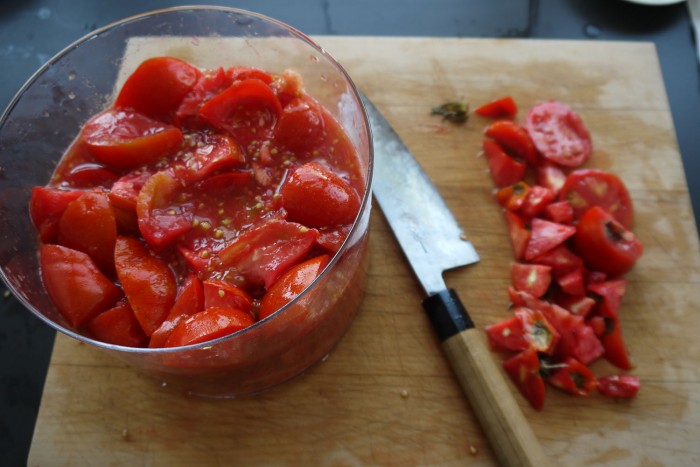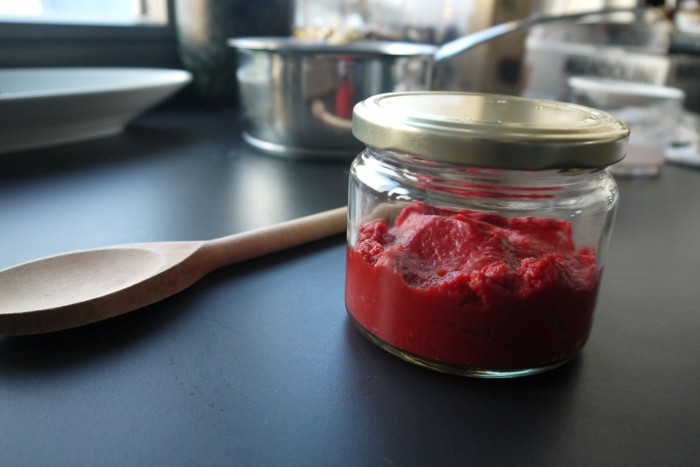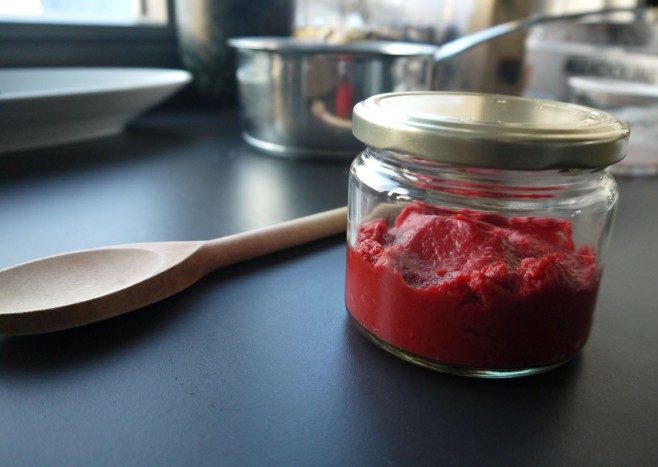
Find that TANG – ZIP – POW in your Tomato SAuce or Paste
Here at Edible Alchemy, we seem to have curious taste buds and are always happy to meet others with the same lust for new flavours, trying something different and maybe a bit out there compared to conventional food preservation.
When I (Alexis) and Natalie first met, it was actually during a tomato-canning workshop at our local university. Our fascination for flavours, food-waste-reduction, food experimentation with preservation techniques was always there. However with this particular technique of canning, we were constantly warned about botulism (one of the most dangerous food born illnesses that exists). We both thought ‘there must be another way’. The chances of botulism were not high if one follows the exact rules of canning…. Which as we both are very much free-style-foodies, we realized that risk was already too big.
With fermentation, there is no chance of botulism to occur as one creates a more acidic environment naturally through the lactic-acid fermentation process. Here I am pleased to have been presented by a fellow workshop participant a tangy, safe and probiotic way of preserving those surplus tomatoes into a thick, rich, and probiotics paste that lasts!

The tomato water that is surplus can also be used as soda-starters (or in your fancy bloody-marry cocktails), backslopping into new krauts, soups, sourdough-bread starters etc.
Here is how to get Started
You can technically start with as many tomatoes as you like as there are not any other ingredients you need to add in proper proportions. And salt is added at the end according to your taste.
You will need
– Tomatoes
– fermentation vessel
– cheese cloth for straining
– salt for flavoring
– Cut or crush tomatoes into your fermentation vessel – a clean glass jar works great
(Feel free to use your hands and incorporate your own unique bacterial blend in the mix)
– Yeasts will start to develop already the same day – there are lots of sugars in tomatoes which yeasts will love to feed on. This yeast needs to be stirred into the mix at least twice a day.

The mixture will be bubbly for around the first 5 days and then around the 6th or so (of course depending on the temp. the ferment is in), it will stop bubbling.

– Using a cheese cloth, strain the tomatoes. Often a yeast will quickly develop on the outside of the cheese cloth. Do not worry about this.
– Once you have your thick paste, save the juice in jars (best to have an airlock to reduce off-flavours building) for further projects. Salt the paste to your taste palette and keep for several months.
Photo and Recipe Credit to Barbara Assheuer



Mine has been fermenting for 5-6 days now but doesn’t have the white layer of yeast on top and is bubbling only slightly. I’m wondering if this has something to do with the fact that I’m using a plastic container to ferment it in. It tastes alright. Tangy, tomatoey.
i would think that its from a lack of yeast on the tomatoes. but dont worry, that should come naturally from the air as well with time. it might just take a bit longer 🙂 enjoy the tang!
Thanks for the reply. I kept going with it and now there is a nice layer of yeast and tang. Will filter it at the weekend and write my results here if interested. The tomatoes were the cheapest you could possibly find, which might have had something to do with the slow pace.
can you leave some liquid to get like a pizza sauce. Sorry about my english, excellent website!!!
yes definitely! very good idea :)! yummm
Hi
I feel like I’ve missed something. Somewhere between crushing the tomatoes in the jar, and straining w a cheesecloth. Do I add anything else to the jar? Thanks.
amazingly enough nope! its just the natural sugars and flesh of the tomatoes and yeasts in the air. salt comes after!
Hi, love this idea. I normally do lactofermentation with salt. Quick question. In the instructions you said to use an airlock. Is that only for the excess juice or the whole process? Thanks in advance.
You can too add salt to start, as one does with most ferments, but this one will happen as fruit fermentation (tomatoes are too a fruit) with the natural yeasts and sugars of the tomato, and then adding salt afterwards.
The airlock is only a suggestion for further fermentation of the juice afterwards to avoid off flavors, but not necessary if you’ll quickly be using it up, drinking it etc. 🙂
Would you be able to use a vinegar starter culture in the tomato juice, place it all in a glass jar with air lock on and then in the end have some sort of tomato-vinegar or fermented tomato puree?
thanks for your opinion on this 🙂
Yes for sure! i never say never – there is always room to experiment. just be aware that with a vinegar starter it will become much more acidic – but thats what you want for a tomato-vinegar right!? let me know how it turns out!
on a side note – i have once made a tomato vinegar which was incredible – using the aerobic (with air) technique! so yes – its possible and every variation will yield new results 😀
I made my own homemade V8 juice by juicing raw tomatoes, onions, and bell peppers while adding a little bit of salt, cumin, and lemon juice. It was very good, however, I left (and forgot) a jar of the juice in the refrigerator for about a month. When found, the flavor and color were good, but with a noticeable solid tang. Is such a fermented juice safe to use in recipes – like that of soups?
hey James, that actually sounds really tasty. you can use that tangy vinegar/juice to liven up your soups or use it for putting other veggies in to do a kind of secondary ferment or as some call it ‘backslopping’ – lots of possibilities here! our noses and tastebuds will tell us if it is ‘off’ or moldy or rancid. tang is not a bad thing though :)!
So I just retrieved from the frig the two quarts of LF tomatoes I did in brine with garlic and basil leaves almost 2 years ago. They smell fine, but I’m a little scared to taste them. Would you still use this stuff? I saw one post suggesting straining and making into paste or pizza sauce. Any other ideas?
wow! that stuff is probably so incredibly UMAMI! i would certainly give it a good smell (which you did – and it smells fine), look for any spots of mold (which you probably would have seen already) and otherwise there isnt potential for botulism here – i would probably use these LF tomatoes for many projects – tomato sauces and and and! but as it sounds from what you wrote, still usable – the magic of fermentation preservation!
I once had an arrabiatta tomato sauce at one of my favorite restaurants.
These fermented tomatoes remind me so much of it. Could this be one of their
secrets? I tried for years to assimilate the flavor and failed until I discovered
fermenting.
being a traditional way to preserve the tomato harvest, i can imagine it might be their secret to the delicious (umami) taste! 🙂
I want to make a fermented pizza sauce. I was going to ferment the tomatoes, basil, onion, carrot, oregano, thyme and a couple of hot peppers together. Then I was going to put it all in a blender after being separated from the brine. Also I would put it through a food mill to remove seeds and skin.
Do you think this approach will work?
this sounds absolutely like a great idea! please let me know how it turns out! just watch that there might be quite a lot of bubbles. feel free to stir once everyday during the fermentation process to bring those bubbles at the bottom to the top and out 🙂
The pizza sauce turned out pretty amazing. It was a bit salty but I added fresh tomato passatta to tone it down a bit.
Once strained, should it be salted or left unsalted? And, should the finished product be kept in the fridge? Thanks~ Can’t wait to try this.
the yeast changes the flavor profile. If you dont want it, ferment in a closed container that you burp when its first going, you wont get yeast.
Great recipe and I’m using it today to turn my jars of fermented tomatoes into paste! What is the shelf life of the paste and where to store? Fridge or cool dark area OK?
thanks!
Alexis!
Why remove the seeds an skin after fermentation which is what I have done both times I have made fermented tomato paste. Is there any reason you know why I should not drain some of the probiotic rich ferment juice for mixing in with dressings etc., then blend the skins and seeds with the pulp and some of the juice for uses as sauce or tomato paste?
—
Deborah
definitely save that juice for more prohects -yes!
Does this become alcoholic after fermenting? Do you ferment at room temperature? Do I need to store it in the fridge afterward?
as its aerobic for most of hte fermentation process it doesnt build up alcohol but goes over that step into vinegar sour. i do store mine in the fridge or if there is a lot, in the cellar – under earth temperature
I’ve had a green apple peel & core & raw honey fermentation on the go for quite some time (actually I totally forgot about it) I’ve had a mason pipe top screwed on and in the beginning there were bubbles oh and I forgot to mention I also have one of those glass pucks inside to keep the cores and peels down. I’ve noticed now that there are no more bubbles and there is a slight brownish sand like film over top of the glass puck. I haven’t opened the jar yet so I don’t know what it smells like. Would you have any idea what this may have turned in to and if it’s fit for consumption in any form?
no more bubbles mean there is no more sugar to ferment – so it’s ‘done’. the film could be yeast poop – like lees – but that usually settles on the bottom. i would certainly open it up and see how it smells at least! doesnt sound very dangerous to me but might smell alcoholic :)!
Can you use canned san Marzano tomatoes in place of fresh ?
do you mean canned tomatoes? you can certainly try! however the natural yeasts on the tomatoes wont be there so maybe you want to add on real tomato to get these yeasts, or rely on the yeasts in the air.
Hi! This thread has been going strong for a while now! Awesome…could I slow the fermentation after crushing with vinegar? Like you would do with fermented hot sauce?
because the fermentation process makes a vinegar itself, we never crush with vinegar – not even hotsauce – we just let the natural vinegar process do the souring 🙂
There seems to be missing instructions on this page. It goes from crush the tomatoes to once you have a thick paste. Seems like quite a bit of missing information to me.
hey mike – i took a look and saw that through new web formatting the font was white and thus you couldnt see it- it should be fixed now
Do you know of any nutritional testing that has been done on lacto-fermented tomato sauce? Specifically, I am wondering what the carbohydrate level is after the yeast have done their thing.
one could certainly do some nutritional testing – however its very expensive for a test thats results will probabl be different the next day. when working with fermented foods, the composition is constantly changing until its vinegar – and in this case the carbohydrate level would be 0 as all the sugars would be eaten up